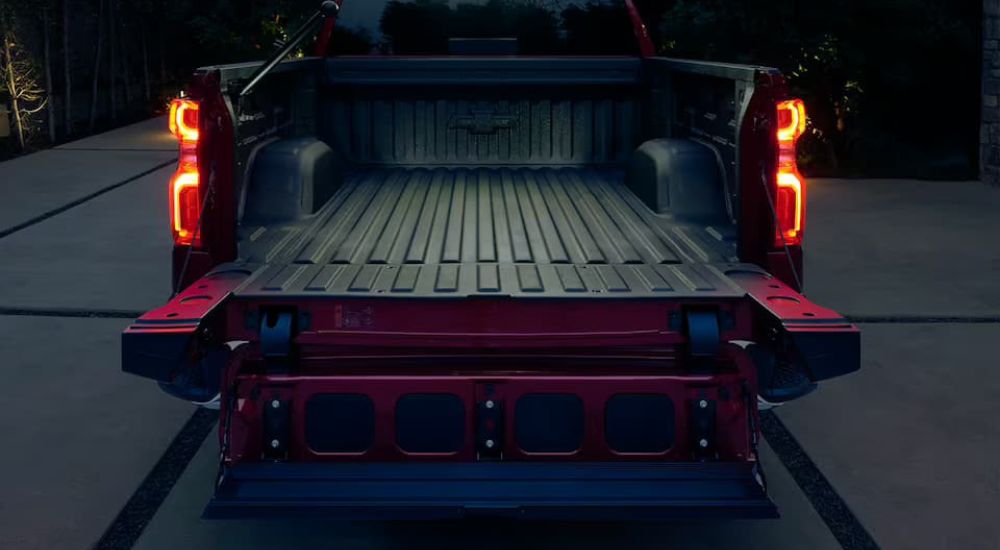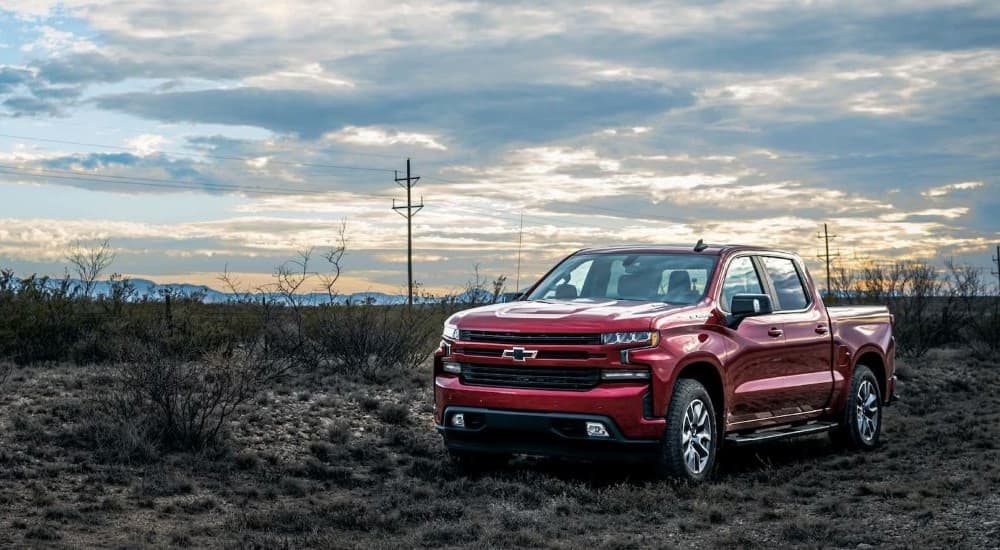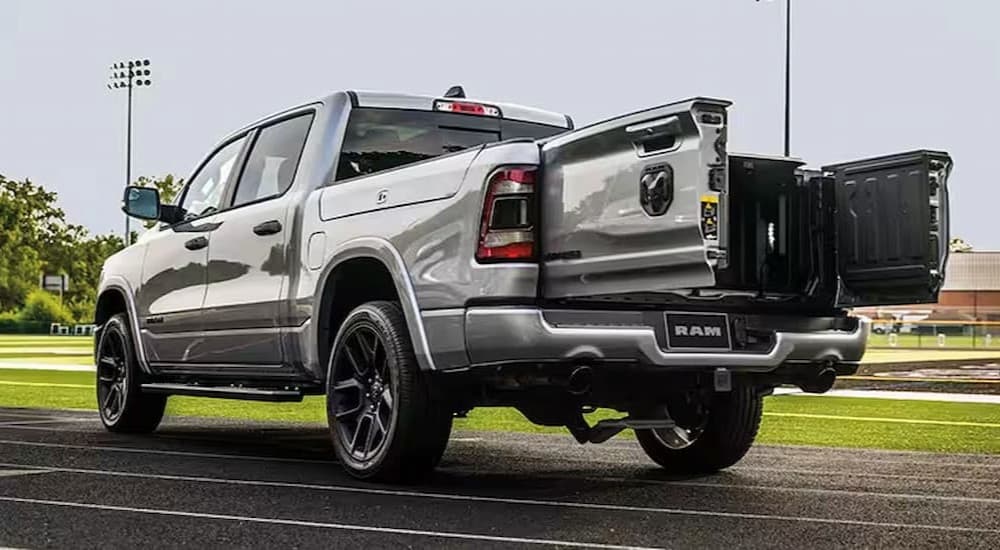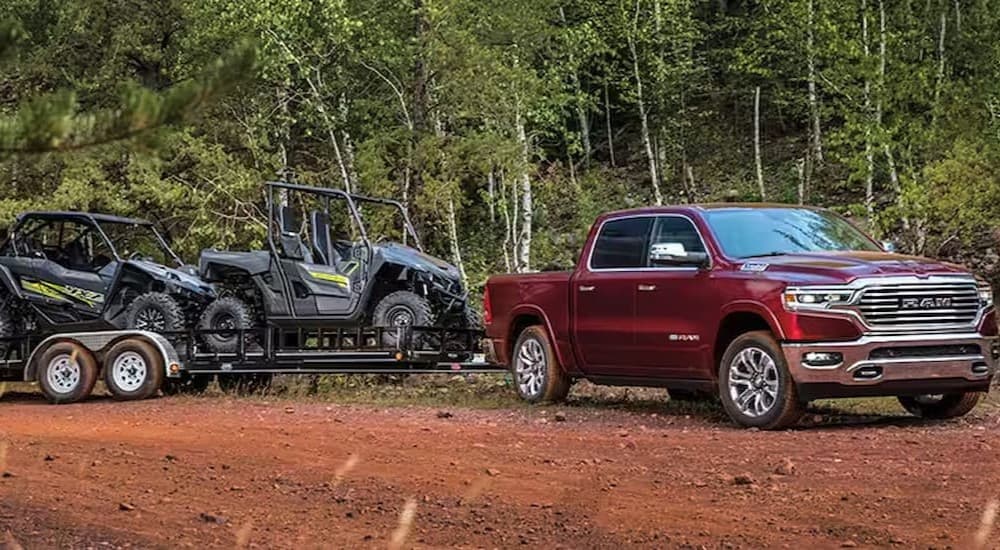Any car aficionado knows nothing is more fun than making comparisons. Just like sports fans debating over what player would come out on top in a hypothetical matchup, automobile fans like to talk about which model can tow more or get faster off the line.
With pickup trucks, there are also beds to compare. We’re going to do just that and examine the 2023 Chevy Silverado 1500 vs 2023 Ram 1500. Both are famed trucks with plenty to offer those invested in towing, hauling, and other labor-related tasks.
How much a truck can tow often gets the most attention when comparing makes and models. This shouldn’t be a surprise: towing limits are higher than payload numbers, and higher numbers are always more exciting to talk about. Yet, we’d bet that most workers end up using the truck’s bed more often than they tow goods. This makes a comparison between the two not only fun but valuable; workers make the country go-’round, and they deserve to know which truck bed will serve them better.

How Do the Truck Beds Work?
On most trucks, beds are attached to the frame separately from the cab, which is why many models let you vary the size of the cab and the bed. For some drivers, a larger cab is preferred for more passengers. (Workers sometimes travel in groups; other times, a pickup does double duty as both a work vehicle and a family vehicle.) For our purposes, though, we’ll look at the bed maximums for the two trucks, assuming you want the best bed you can purchase, even if that means the cab is a little smaller.
Any comparison has to come with caveats, though. The payload a bed can carry is important, but the design of a bed is just as imperative. A well-designed bed will let you maximize its space. You could have a high payload count, but if the bed’s design means it’s difficult to fit anything into it, then you cannot take advantage of what your bed has to offer, which means the payload limit is a rather misleading statistic.
Who Has the Superior Design?
Both of these trucks are well-designed. They’ve been around for years, so engineers have been able to improve the truck each year, perfecting their respective models. It’s doubtful you’d be let down by one bed’s design, but there is one that comes out a bit ahead in our book. Let’s explore why.
Bed Volume
The Chevy Silverado’s bed can range from five feet, ten inches (the shortest bed) to eight feet, two inches (the longest bed). The long bed gives you 89.5 cu.ft. of volume, which sets the Silverado ahead of most other trucks on the market today. With this limit, you can pack in quite a lot under a tonneau cover. The bed’s height is 22.4 inches, which lets you get the most out of all that volume; without a solid height, you might not be able to take advantage of the weight your truck can handle—unless you go topless, that is.
The 2023 Ram has beds that range from five feet, seven inches (the shortest bed available) to six feet, four inches (the largest bed available). These numbers are a fair bit smaller than the Silverado’s; that’s one reason that the Silverado inevitably comes out ahead of the Ram. The Ram’s shorter bed limits what you can get inside it. Similarly, the Ram’s height measures less, too, coming in at 21.5 inches. The total volume allowed is subsequently less, coming in at 61.5 cu.ft.—about two-thirds that of the Silverado 1500.
In terms of dimensions, you’ll be able to get a lot more out of your Silverado. Look, the Ram will still treat you well. You can get a lot out of those numbers, but the Silverado leaps ahead. If you’re a worker, you want to know that you can get the most out of your truck, and the Silverado will allow you to do just that.
Bed Payload
The payload will vary depending on the bed size and the engine. The better your engine, the higher your payload can be. For our purposes, we’ll assume you’re interested in the maximum payload just as you were interested in the maximum volume. If you’re a worker, you’re probably going to someday push the limits on your payload and towing.
The payloads of these two are not too different. The Silverado has a top limit of 2,260 lbs, while the Ram tops at 2,300 lbs. The Ram comes out a bit ahead, but the volume and height issues make the difference in these numbers a little misleading.
Since the volume and height aren’t as aggressive as the Silverado’s, you might find yourself unable to take advantage of the Ram’s marginally higher payload. That’s why we mentioned that design plays just as large a part as payload limit. If your truck’s design isn’t up to snuff, your payload limit will end up lower than the advertised number in most cases. Unless your load is super dense, you’re more likely to get more out of a Silverado’s bed than that of a Ram.
Bed Tech
In our era of advanced technology, there’s no reason not to have your truck be able to report on the fitness of your bed.
The Silverado’s camera system has the ability to zoom in on areas of your bed in case you’re worried about any movement back there. If you hit a bump in the road or make a sharp turn, you’ll want to be certain that everything in the bed is still sitting right. This camera lets you do that.
Then there’s the tech that lets you know the state of your vehicle, which can definitely change depending on how much you’re carrying. The Silverado’s digital information center lets you know about the vehicle’s weight and tire distribution at any moment. Naturally, with the added weight, your truck will have more to handle, and it’s always good to know how it’s impacting your vehicle’s performance.
The Silverado 1500’s StabiliTrak program will adjust your truck’s traction depending on how much weight it’s carrying and in accordance with the terrain you’re traversing. If the terrain is rough, you don’t have to worry about your payload; the StabiliTrak will reduce your stress by matching your truck’s performance with the road, reducing the chance your payload will shift around.
The Ram’s Head-Up Display (HUD) does much the same, reporting on your truck’s current status. It, too, has an extensive camera system that will keep you informed of what’s going on in the bed. While much of this tech is similar, we’re not sure the Ram has anything that meets the StabiliTrak program, a favorite of ours.
Towing Limits
Whoa, whoa, whoa. Towing? We were talking about payload, right?
We were, yeah, but towing matters here. If you max out your payload or cannot fit something into your bed, you might have to turn to towing, so it’s good to know how the towing limits line up. Unsurprisingly, both of these trucks have high limits. That’s a major selling point.
The Silverado has 13,300 lbs of towing ability, while the Ram has 12,750 lbs. All things considered, these numbers are not that far apart, but the Silverado once again comes out as the winner.
The Better Bed Belongs to the Silverado
Even though the Silverado’s maximum payload limit is a little lower than the Ram’s, the other factors of their cargo beds ultimately give the Silverado the advantage. If you’re a hard worker who wants to feel confident about your payload, the Silverado might be your best bet.






